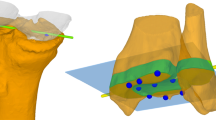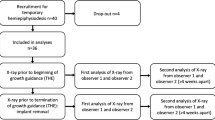Summary.
The diagnosis of malalignments of the lower extremities includes analysis of the geometry of the whole leg. The first step in the diagnostic process is a standardized physical examination. It provides valuable background information for an effective radiological diagnosis. Even with a thorough standardized physical examination it is not possible to define exactly the deformity or decide on an operative procedure. The diagnosis of axis deviations in the frontal plane can be measured on a conventional plain X-ray of the whole leg. In this view it is very important that the knee joints are in a true a. p. view independent on torsional deformities of the lower legs. Today the gold standard to measure the torsion and length of the lower extremities is the CT scan. However, the multitude of analytical methods for CT measurements described in the literature do not lend themselves readily to comparison; thus, it is difficult to identify a clear method of choice. Not every CT measurement is better than a physical examination. Evidence of reproducibility and accuracy is a prerequisite for useful interpretation of the results. Up to this point in the literature there are only reference values for the Ulm CT Method. One alternative is the MR scan, which avoids radiological risks, but the reproducibility and accuracy of the MRI method are not as good as for the CT method. Another alternative is ultrasound, where recent advances in the measurement of torsion and length of the lower extremities have proven competitive with or superior to the accuracy of MRI. The three-dimensional determination of the torsion and length of the lower extremities by ultrasound has now assumed a leading role in the non-radiological diagnosis of malalignments of the lower extremities in children and adolescents. This method furthermore is increasingly being used in preoperative planning of leg deformities in adults.
Zusammenfassung.
Die Diagnostik von posttraumatischen Deformitäten im Bereich der unteren Extremität umfaßt die Analyse der gesamte Beingeometrie. Die standardisierte klinische Untersuchung ist das erste Glied in der diagnostischen Kette, sie liefert wertvolle Hinweise für die anschließende bildgebende Diagnostik. Durch sie allein kann weder eine Fehlstellung ausreichend genau beschrieben, noch eine Indikation zur Operation gestellt werden. Die Diagnostik von Achsenabweichungen in der Frontal- und Sagittalebene erfolgt durch exakt eingestellte konventionelle radiologische Aufnahmen. Goldstandard zur Torsionswinkel- und Längenbestimmung ist die Computertomographie. Dennoch können die unterschiedlichen Methoden nur bedingt miteinander vergleichen werden. Nicht jede computertomographische Messung ist der klinischen Untersuchung überlegen. Der Nachweis der Reproduzierbarkeit und Genauigkeit ist für die Interpretation der Ergebnisse Voraussetzung. Normwerte wurden bisher nur für die Ulmer Methode publiziert. Die einzigen Vorteile der Kernspintomographie bei der Bestimmung der Beintorsion sind die fehlende Strahlenbelastung und die gute Darstellung von noch nicht vollständig verknöcherten Epiphysen bei Kindern im Vorschulalter. Ihre Genauigkeit und Reproduzierbarkeit ist jedoch der Computertomographie unterlegen. Fortschritte bei der sonographischen Bestimmung der Beingeometrie haben diese Vorteile relativiert. Die dreidimensionale sonographische Bestimmung der Beingeometrie hat einen festen Platz in der Diagnostik von Fehlstellungen bei Kindern und Jugendlichen eingenommen. Sie wird zunehmend auch zur präoperativen Planung bei Erwachsenen eingesetzt.
Similar content being viewed by others
Author information
Authors and Affiliations
Rights and permissions
About this article
Cite this article
Keppler, P., Strecker, W. & Kinzl, L. Analyse der Beingeometrie – Standardtechniken und Normwerte. Chirurg 69, 1141–1152 (1998). https://doi.org/10.1007/s001040050551
Issue Date:
DOI: https://doi.org/10.1007/s001040050551




